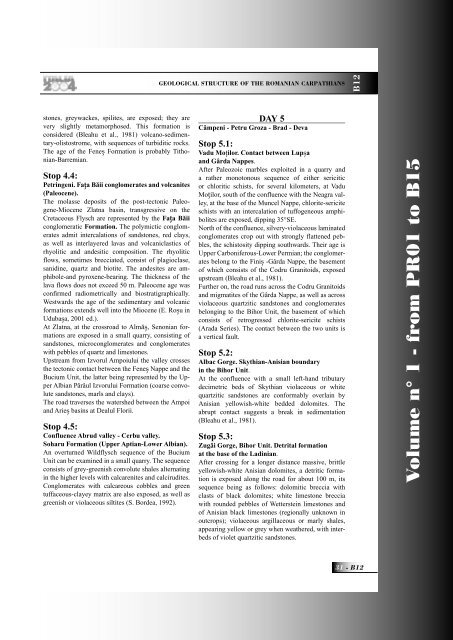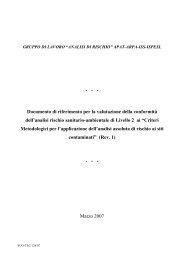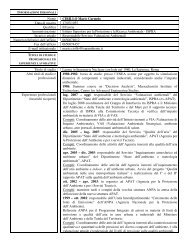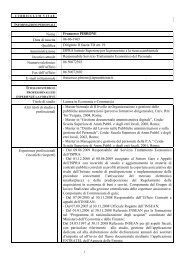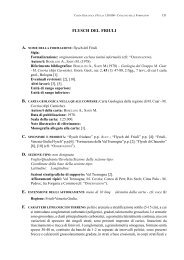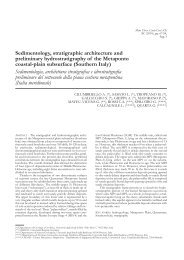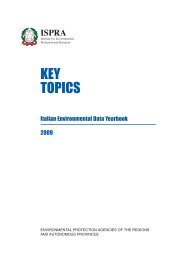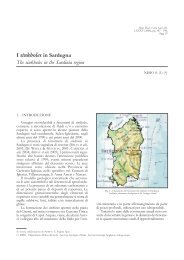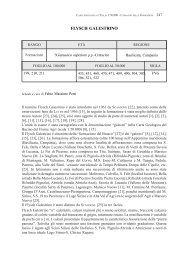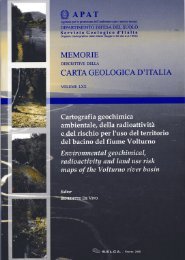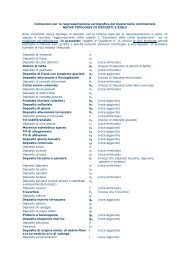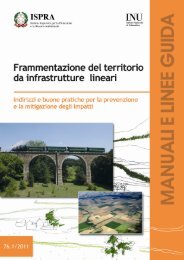Guidebook - Ispra
Guidebook - Ispra
Guidebook - Ispra
Create successful ePaper yourself
Turn your PDF publications into a flip-book with our unique Google optimized e-Paper software.
stones, greywackes, spilites, are exposed; they are<br />
very slightly metamorphosed. This formation is<br />
considered (Bleahu et al., 1981) volcano-sedimentary-olistostrome,<br />
with sequences of turbiditic rocks.<br />
The age of the Feneș Formation is probably Tithonian-Barremian.<br />
Stop 4.4:<br />
Petringeni. Faţa Băii conglomerates and volcanites<br />
(Paleocene).<br />
The molasse deposits of the post-tectonic Paleogene-Miocene<br />
Zlatna basin, transgressive on the<br />
Cretaceous Flysch are represented by the Faţa Băii<br />
conglomeratic Formation. The polymictic conglomerates<br />
admit intercalations of sandstones, red clays,<br />
as well as interlayered lavas and volcaniclastics of<br />
rhyolitic and andesitic composition. The rhyolitic<br />
flows, sometimes brecciated, consist of plagioclase,<br />
sanidine, quartz and biotite. The andesites are amphibole-and<br />
pyroxene-bearing. The thickness of the<br />
lava flows does not exceed 50 m. Paleocene age was<br />
confirmed radiometrically and biostratigraphically.<br />
Westwards the age of the sedimentary and volcanic<br />
formations extends well into the Miocene (E. Roșu in<br />
Udubașa, 2001 ed.).<br />
At Zlatna, at the crossroad to Almăș, Senonian formations<br />
are exposed in a small quarry, consisting of<br />
sandstones, microconglomerates and conglomerates<br />
with pebbles of quartz and limestones.<br />
Upstream from Izvorul Ampoiului the valley crosses<br />
the tectonic contact between the Feneș Nappe and the<br />
Bucium Unit, the latter being represented by the Upper<br />
Albian Pârâul Izvorului Formation (coarse convolute<br />
sandstones, marls and clays).<br />
The road traverses the watershed between the Ampoi<br />
and Arieș basins at Dealul Florii.<br />
Stop 4.5:<br />
Confluence Abrud valley - Cerbu valley.<br />
Soharu Formation (Upper Aptian-Lower Albian).<br />
An overturned Wildflysch sequence of the Bucium<br />
Unit can be examined in a small quarry. The sequence<br />
consists of grey-greenish convolute shales alternating<br />
in the higher levels with calcarenites and calcirudites.<br />
Conglomerates with calcareous cobbles and green<br />
tuffaceous-clayey matrix are also exposed, as well as<br />
greenish or violaceous siltites (S. Bordea, 1992).<br />
GEOLOGICAL STRUCTURE OF THE ROMANIAN CARPATHIANS<br />
DAY 5<br />
Câmpeni - Petru Groza - Brad - Deva<br />
Stop 5.1:<br />
Vadu Moţilor. Contact between Lupșa<br />
and Gârda Nappes.<br />
After Paleozoic marbles exploited in a quarry and<br />
a rather monotonous sequence of either sericitic<br />
or chloritic schists, for several kilometers, at Vadu<br />
Moţilor, south of the confluence with the Neagra valley,<br />
at the base of the Muncel Nappe, chlorite-sericite<br />
schists with an intercalation of tuffogeneous amphibolites<br />
are exposed, dipping 35°SE.<br />
North of the confluence, silvery-violaceous laminated<br />
conglomerates crop out with strongly flattened pebbles,<br />
the schistosity dipping southwards. Their age is<br />
Upper Carboniferous-Lower Permian; the conglomerates<br />
belong to the Finiș -Gârda Nappe, the basement<br />
of which consists of the Codru Granitoids, exposed<br />
upstream (Bleahu et al., 1981).<br />
Further on, the road runs across the Codru Granitoids<br />
and migmatites of the Gârda Nappe, as well as across<br />
violaceous quartzitic sandstones and conglomerates<br />
belonging to the Bihor Unit, the basement of which<br />
consists of retrogressed chlorite-sericite schists<br />
(Arada Series). The contact between the two units is<br />
a vertical fault.<br />
Stop 5.2:<br />
Albac Gorge. Skythian-Anisian boundary<br />
in the Bihor Unit.<br />
At the confluence with a small left-hand tributary<br />
decimetric beds of Skythian violaceous or white<br />
quartzitic sandstones are conformably overlain by<br />
Anisian yellowish-white bedded dolomites. The<br />
abrupt contact suggests a break in sedimentation<br />
(Bleahu et al., 1981).<br />
Stop 5.3:<br />
Zugăi Gorge, Bihor Unit. Detrital formation<br />
at the base of the Ladinian.<br />
After crossing for a longer distance massive, brittle<br />
yellowish-white Anisian dolomites, a detritic formation<br />
is exposed along the road for about 100 m, its<br />
sequence being as follows: dolomitic breccia with<br />
clasts of black dolomites; white limestone breccia<br />
with rounded pebbles of Wetterstein limestones and<br />
of Anisian black limestones (regionally unknown in<br />
outcrops); violaceous argillaceous or marly shales,<br />
appearing yellow or grey when weathered, with interbeds<br />
of violet quartzitic sandstones.<br />
B12<br />
31 - B12<br />
Volume n° 1 - from PR01 to B15


